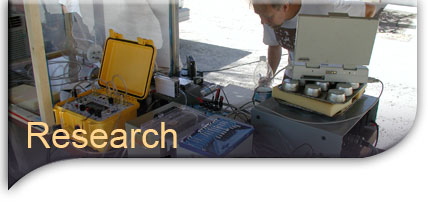|

Surrounding and Potential Study Areas
Research and educational offerings in close proximity include the Kelso Sand Dunes, Devil's Playground, Cima Volcanic Field, Cima Dome, the Providence, Granite, and New York mountain ranges, Afton Canyon, Salt Creek, Sheep Creek Springs, and Landfair and Ivanpah Valleys. Elevations range from 945 feet at the Center to over 7,900 feet at Clark Mountain, in the Clark Mountain Range. As the gateway to the entire Mojave National Preserve and Death Valley National Park, there is easy access to fossil sites, the remains of Indian villages, historic wagon trails, old army forts, mining sites, and the salt flats of Silurian and Soda Dry Lakes. The Desert Studies Center provides a multi-station kitchen, bathhouse, laboratory, computer lab, Internet access via a satellite uplink, two classrooms, a modest library, soaking pool, and long term researcher's quarters. Facilities and equipment available include microscopes, dissecting scopes, computers, field gear, black lights, and 18 inch telescope.
Permits and Applications
Research conducted at the Desert Studies Center requires a DSC Research Permit Application to be completed and emailed to the Site Manager, Robert Fulton rfulton@fullerton.edu prior to the start of the project. Additional permits from the Mojave National Preserve and/or Death Valley National Park (the NPS Research Permit and Reporting System) may be required depending on the location of the research site. A California Fish and Game research/collecting permit is required for research dealing with all animals and plants, along with a current California State Fishing License for research involving invertebrates, fish, amphibians and reptiles. A Fish and Wildlife Service permit is required for research dealing with protected or endangered species. Judith Presch Desert Research Scholarship
Open to: Undergraduate (one award) Graduate (one award) students pursuing research in the Mojave Desert. Named in memory of Judith A. Presch, Human Resource Specialist, California State University, Fullerton and Desert Studies Center Supporter. Awarded annually to one undergraduate and one graduate student working through the Desert Studies Center, Zzyzx, California. Successful applicants may also have all fees waived for use of the Desert Studies Center facilities for one year. Applications will be reviewed and evaluated by the Research Award Committee of the California Desert Studies Consortium. Awards will be announced in November. For additional information and application contact the Desert Studies Office at Department of Biological Science, California State University, Fullerton.
Titles of Recently Funded Proposals
Foraging behavior of desert rodents in response to predator odors. Effects of small mammals on pot-fire vegetation recovery in the Mojave National Preserve. Factors Affecting Reproductive Output in Desert Holly (Atriplex hymenelytra). A Phylogenteic Study of the Mojave Desert Icon, Yucca brevifolia (Joshus Tree). Microhabitat Patch Use and Movement Patterns in Uta stansburiana Populations Fragmented by Wildfire in the Mojave National Preserve. A Hydrogeologic Model and Water Budget at Zzyzx Desert Studies Center. Population census of reptiles in the Soda Springs area. Depositional Environment and Sequence Stratigraphy of the Nine Mile Formation of Early to Middle(?) Ordovician age, of the Pogonip Group. Factors Affecting the Distribution and Abundance of Seeds Produced by Desert Holly (Atriplex hyymenelytra). Comparing water relations between two coexisting halophytic desert shrub species that differ in their photosynthetic pathways. A Detailed Geologic Map and Reinterpretation of the Clark Mountain-Mohawk Ridge Area, Mountain Pass California. Prehistoric Mojave Desert Ceramics and Luminescence Dating. Impact of Land Degradation on Nebkha Dunes along the Mojave River, California. Mate Location Behavior in Sidewinder Rattlesnakes (Crotalus cerastes). Effects of granivory on post-fire vegetation recovery in a sagebrush-juniper community of the Mojave Desert. Comparing water relations between two coexisting halophytic desert shrub species that differ in their photosynthetic pathways.
|